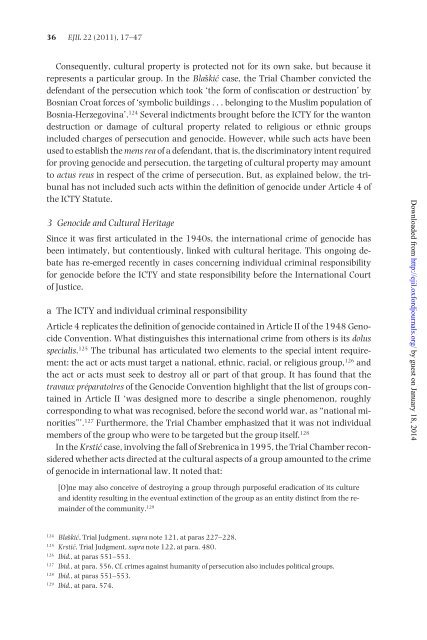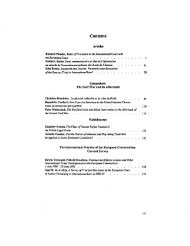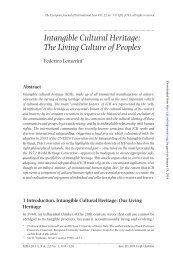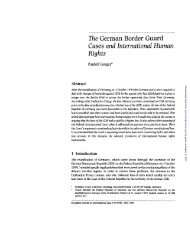Genocide and Restitution - European Journal of International Law
Genocide and Restitution - European Journal of International Law
Genocide and Restitution - European Journal of International Law
You also want an ePaper? Increase the reach of your titles
YUMPU automatically turns print PDFs into web optimized ePapers that Google loves.
36 EJIL 22 (2011), 17–47<br />
Consequently, cultural property is protected not for its own sake, but because it<br />
represents a particular group. In the Blaškić case, the Trial Chamber convicted the<br />
defendant <strong>of</strong> the persecution which took ‘the form <strong>of</strong> confiscation or destruction’ by<br />
Bosnian Croat forces <strong>of</strong> ‘symbolic buildings . . . belonging to the Muslim population <strong>of</strong><br />
Bosnia-Herzegovina’. 124 Several indictments brought before the ICTY for the wanton<br />
destruction or damage <strong>of</strong> cultural property related to religious or ethnic groups<br />
included charges <strong>of</strong> persecution <strong>and</strong> genocide. However, while such acts have been<br />
used to establish the mens rea <strong>of</strong> a defendant, that is, the discriminatory intent required<br />
for proving genocide <strong>and</strong> persecution, the targeting <strong>of</strong> cultural property may amount<br />
to actus reus in respect <strong>of</strong> the crime <strong>of</strong> persecution. But, as explained below, the tribunal<br />
has not included such acts within the definition <strong>of</strong> genocide under Article 4 <strong>of</strong><br />
the ICTY Statute.<br />
3 <strong>Genocide</strong> <strong>and</strong> Cultural Heritage<br />
Since it was first articulated in the 1940s, the international crime <strong>of</strong> genocide has<br />
been intimately, but contentiously, linked with cultural heritage. This ongoing debate<br />
has re-emerged recently in cases concerning individual criminal responsibility<br />
for genocide before the ICTY <strong>and</strong> state responsibility before the <strong>International</strong> Court<br />
<strong>of</strong> Justice.<br />
a The ICTY <strong>and</strong> individual criminal responsibility<br />
Article 4 replicates the definition <strong>of</strong> genocide contained in Article II <strong>of</strong> the 1948 <strong>Genocide</strong><br />
Convention. What distinguishes this international crime from others is its dolus<br />
specialis. 125 The tribunal has articulated two elements to the special intent requirement:<br />
the act or acts must target a national, ethnic, racial, or religious group, 126 <strong>and</strong><br />
the act or acts must seek to destroy all or part <strong>of</strong> that group. It has found that the<br />
travaux préparatoires <strong>of</strong> the <strong>Genocide</strong> Convention highlight that the list <strong>of</strong> groups contained<br />
in Article II ‘was designed more to describe a single phenomenon, roughly<br />
corresponding to what was recognised, before the second world war, as “national minorities”’.<br />
127 Furthermore, the Trial Chamber emphasized that it was not individual<br />
members <strong>of</strong> the group who were to be targeted but the group itself. 128<br />
In the Krstić case, involving the fall <strong>of</strong> Srebrenica in 1995, the Trial Chamber reconsidered<br />
whether acts directed at the cultural aspects <strong>of</strong> a group amounted to the crime<br />
<strong>of</strong> genocide in international law. It noted that:<br />
Downloaded from http://ejil.oxfordjournals.org/ by guest on January 18, 2014<br />
[O]ne may also conceive <strong>of</strong> destroying a group through purposeful eradication <strong>of</strong> its culture<br />
<strong>and</strong> identity resulting in the eventual extinction <strong>of</strong> the group as an entity distinct from the remainder<br />
<strong>of</strong> the community. 129<br />
124<br />
Blaškić, Trial Judgment, supra note 121, at paras 227–228.<br />
125<br />
Krstić, Trial Judgment, supra note 122, at para. 480.<br />
126<br />
Ibid., at paras 551–553.<br />
127<br />
Ibid., at para. 556. Cf. crimes against humanity <strong>of</strong> persecution also includes political groups.<br />
128<br />
Ibid., at paras 551–553.<br />
129<br />
Ibid., at para. 574.








